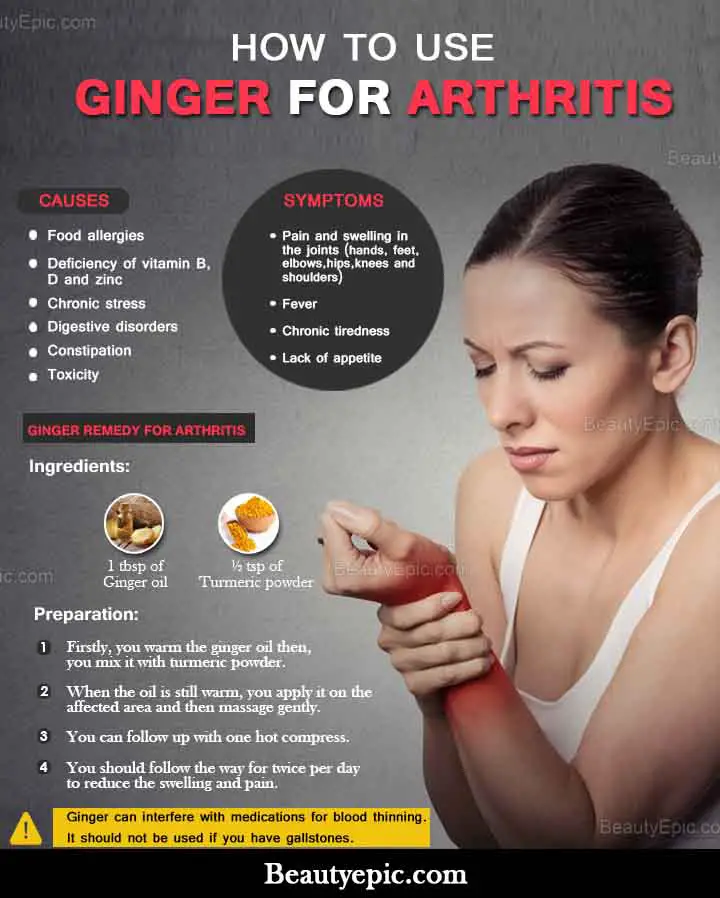
Important: This article is for informational purposes only. Please read our full disclaimer for more details.
Arthritis is a condition in which there is an inflammation in one or more joints of the body, including knees, fingers, elbows, wrist and shoulders. The affected area becomes swollen and makes it extremely painful. Ginger finds space in spice cabinets of all almost all homes but is lesser known fact that it can also find a very useful place in your medicine cabinets. Besides being helpful in soothing upset stomach, it relieves pain and inflammation, two of the main symptoms of arthritis. Here we discuss how to use ginger for arthritis pain.
Does Ginger Help In Relieving Arthritis Pain?
- It is anti-inflammatory, anti-ulcer, and antioxidant.
- Ginger root is packed with several anti-inflammation phytonutrients, called gingerols, that help combat arthritis.
- The aromatic oils and nutrients in ginger also help in relieving pain and inflammation.
- It slows down the progress of the disease and minimizes joint inflammation or swelling, therefore improving the quality of life.
How to Use Ginger for Arthritis?
This condition cannot be cured completely, but can only be mitigated with the help of medications. Natural home remedies can work equally effectively to help minimize the problem. Ginger as a natural remedy has proven an effective cure for arthritis.
1. Ginger for Arthritis
- You can add a few teaspoons of peeled and crushed ginger to your vegetables, soups, cookies, breads, candies, and tea.
- You can have a mixture of half teaspoon raw honey and half teaspoon of fresh ginger juice every day to reduce arthritis joint pain.
- You can add one teaspoon of ginger powder to a cup of water and drink it once every day for a couple of days to get relief from joint pain.
- You can prepare a refreshing ginger drink using half inch of crushed ginger, juice of half a lime, and black salt.
- Ginger also comes in capsules, tinctures, teas, powders, and foods made from the dried or fresh root of the ginger plant.
2. Ginger Oil And Olive Oil for Arthritis
- Add two to three drops of pure ginger oil to two tablespoons of warm extra virgin olive oil.
- Apply the mixture on the affected area. Follow it up with a gentle massage and a hot fomentation for best results.
3. Ginger, Ginger Oil And Water for Arthritis
- Take freshly crushed ginger, ginger oil and water in a vessel and boil it.
- Add normal water and a little salt to the mixture to bring it to a comfortable temperature for soaking your hand and feet for 20 minutes.
- This improves blood circulation and eases arthritis pain.
4. Ginger Oil And Mustard Oil for Arthritis
- Mix two drops of ginger oil with mustard oil.
- Massage the mixture on the areas wherever required twice a day followed by hot compress.
- It reduces swelling and pain.
[ Read: How to Use Turmeric for Arthritis? ]
5. Ginger and Turmeric for Arthritis
- Mix one tablespoon of warm ginger oil with 1/2 teaspoon turmeric powder.
- Massage gently on the affected area twice a day.
- It eases swelling and pain.
Tips and Precautions:
- For best results, use fresh ginger and pure ginger oil.
- Concentrated doses of ginger can cause stomach upset. So take ginger capsules with food.
- Do not take ginger if you’re taking a blood-thinning medication, as ginger may reverse the effects of these drugs.
- Do not consume more than 4 grams of ginger per day.
You Might Also Like:
- Fish Oil for Arthritis: Does it Really Work?
- Does Ginger Help with Nausea?
- 15 Side Effects Of Ginger You Should Be Aware Of
- The 10 Best Foods For An Upset Stomach
- Turmeric Tea: Preparation,Benefits and Recipes
- 10 Serious Side Effects of Turmeric You Must Know
Image:- 1















